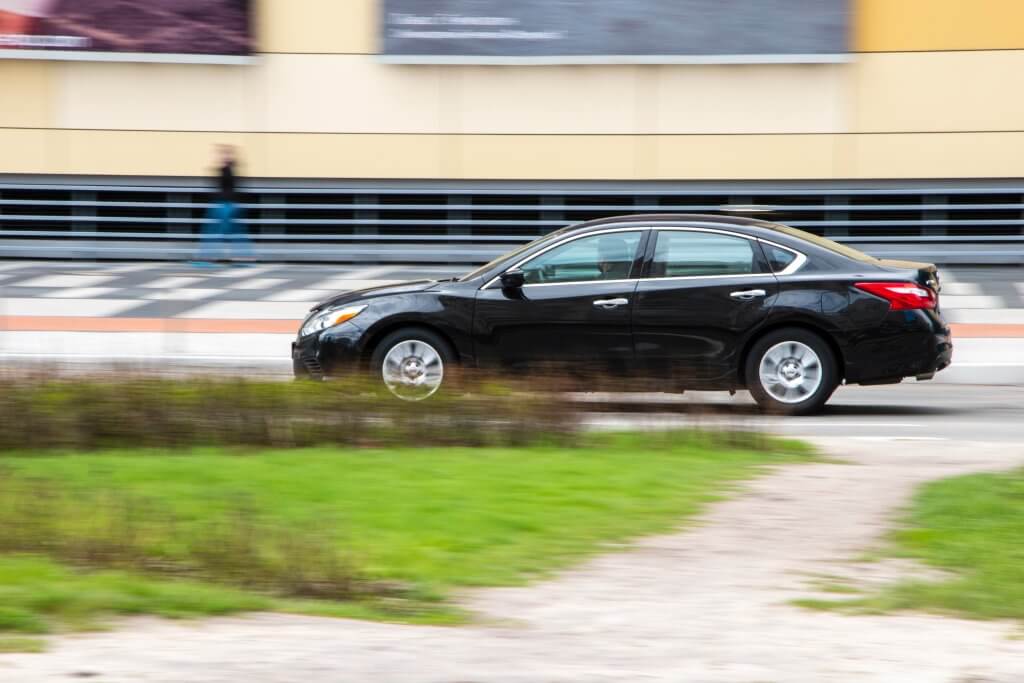The Nissan Altima is one of the best selling mid-size sedans on the market. It was introduced in 1992 to replace the Stanza, discontinued that year. It is the American version of the Nissan Bluebird, a line that began production in 1955 in Japan.
The Altima is primarily used as a family vehicle, for travel, and for commutes. Knowing which years of the Nissan Altima are reliable and have low up keep costs is essential if this model is on your list of purchase considerations or if you have one sitting in the driveway already.
Below we will give you a few recommendations on years that are worth the money and years that aren’t. We recommend avoiding specific years based on their reliability, safety, and other factors.
Our data comes from FIXD scanners in thousands of Nissan Altimas, along with surveys submitted by owners AND several public sources such as the National Highway Traffic Safety Administration (NHTSA), Kelley Blue Book (KBB), and Fueleconomy.gov.
Listed below is a summary of our results. Continue reading to find a detailed report about the best and worst years of Nissan Altima.
| Best Years | Why? | Worst Years | Why? |
| 2010 |
Low repair costs, high reliability scores |
2001 |
Annual repair costs as high as the car’s value, low safety rating |
| 2012 |
Good Rollover safety score, low number of recalls |
2002-2004 |
Low reliability scores, increased number of DTCs |
| 2013-2015 |
Good fuel economy, below average costs, high owner reliability scores |
2005-2006 |
Low safety scores, high chance of a repair costing over $500 |
| 2016-2018 |
High reliability scores, low annual maintenance and repair costs |
2007-2009 |
Beginning of 4th generation, high repair costs |
| 2019-2021 |
High reliability scores from both FIXD data and owner surveys, low number of DTCs |
2011 |
High repair costs, low safety ratings |
If you’d like to see an in depth comparison of this vehicles competitors, check out:
Nissan Altima Vs Nissan Sentra
Nissan Altima Vs Toyota Corolla
Nissan Altima MPG, Engine Reliability Score, & Safety Ratings Year by Year
Before looking at the best and worst years of the Nissan Altima, let’s break down how we compiled our list. First, we analyzed FIXD Reliability Scores, Owner Reliability Scores, and safety ratings from the NHTSA. We also considered the fuel economy, KBB value, and costs to own and repair the car.
You’ll notice that the first year of most generations has multiple issues; there’s usually a rocky start to any new design. The new generation almost always has some kinks to work out and those kinks often result in check engine lights. This increase in check engine lights and trouble codes in the first model year of most generations causes a drop in the reliability score, such as in 2007 and 2002 for the Altima.
Also heres an article we wrote about the Nissan CVT transmission you might find helpful.
If you’re in the market for a car, take a look at our article on the USAs’ most reliable and cheapest to repair cars in the U.S. Don’t get stuck with a lemon, use our data to help you shop.
Engine Reliability Score – Over The Years
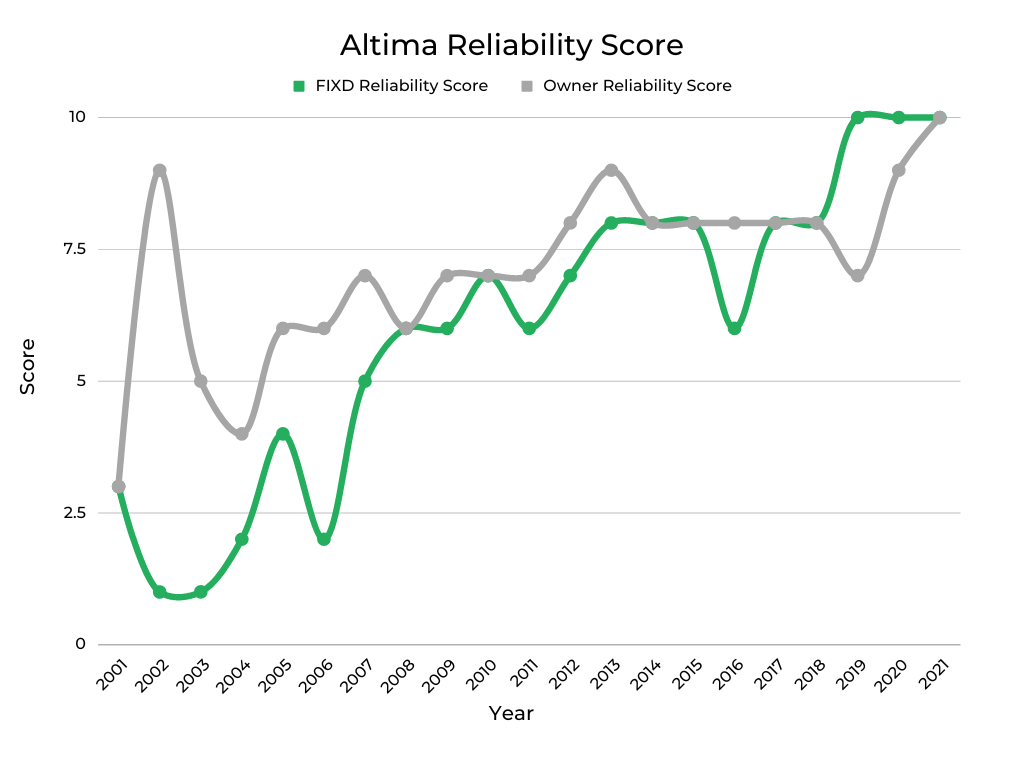
For the FIXD Reliability Score (green line), we analyzed the number of check engine lights (CELs) recorded by FIXD sensors in Nissan Altimas with the device installed. The FIXD Reliability Score is based on the number of CELs per car weighted by mileage. It’s a scale of 1-10, with 5 being average, 1 being the worst, and 10 being the best.
The second score, the Owner Reliability Score (gray line), was derived from owner surveys and is on the same scale as the FIXD Reliability Score.
The two scores follow a similar path, with newer models of the Nissan Altima being the most reliable. However, some noticeable dips and peaks in the graph deserve extra attention.
The 2002 Nissan Altima has a higher Owner Reliability Score than the FIXD Reliability Score. This disagreement is likely caused by owners either believing their car is more reliable than it is or being accepting of the increased number of check engine lights in their older model. Backing up our hunch here – 2002 is the first year of the 3rd generation, making it even more likely that the car isn’t reliable.
There is also a noticeable drop in the FIXD Reliability Score in 2016.
If you’d like to see some of the common trouble codes for Nissan check engine lights, we list the top codes for each Nissan model.
NHTSA Safety Score – Over The Years
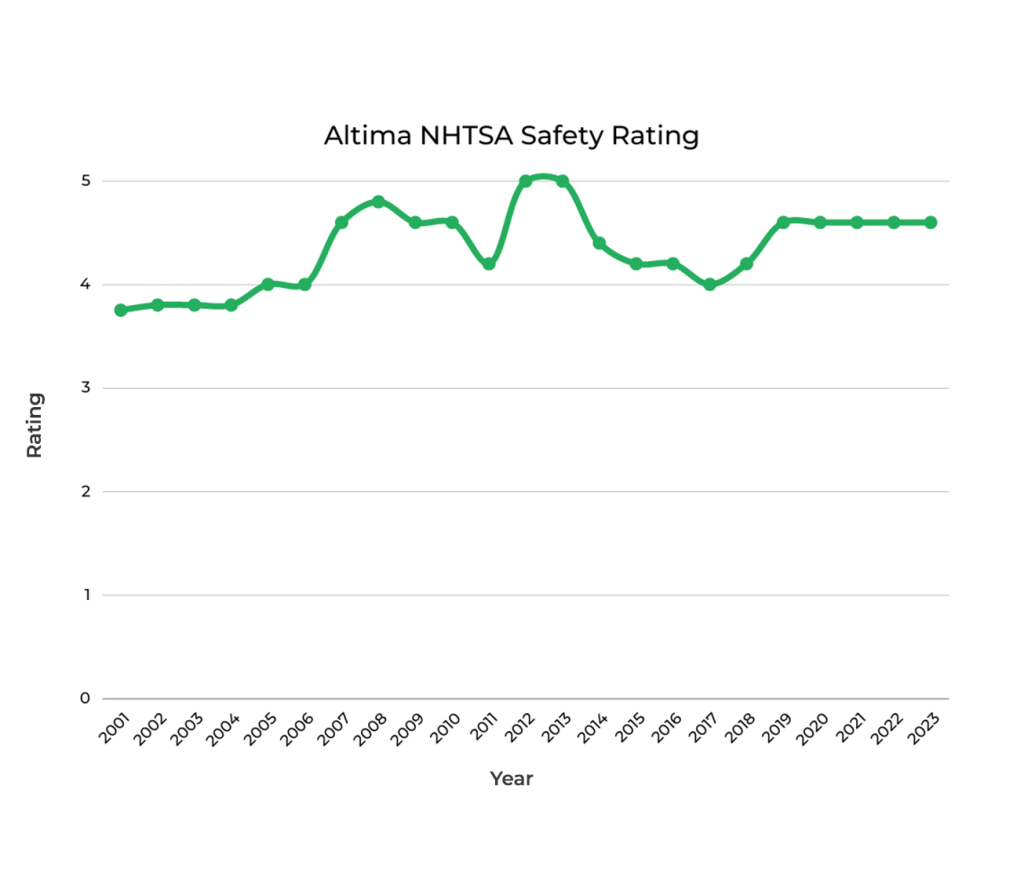
The Nissan Altima has a history of good safety ratings from the NHTSA as of late. It has scored a solid 4.6 out of 5 over the last five years and received a perfect five out of five in 2012 and 2013. Comparing similar vehicles, the Toyota Camry received a safety rating of 5/5 over the last five years, and the Honda Civic scored 4.4 and 4.2 in 2012 and 2013.
However, the Nissan Altima’s early years have low ratings, sharply dropping in 2011. And, although 2012 and 2013 were great, we saw a full point drop off of the average safety score between 2013 to 2017.
Since the Nissan Altima is mainly used as a family car and commute vehicle, it is important to have high safety standards. In addition, a great performance in crash tests can result in low insurance costs, a necessary expense for vehicle ownership.
If you live in one of the states listed below, we can show you the cheapest vehicles to insure in yours.
| What Used Cars Are the Cheapest To Insure In: |
| Ohio |
| North Carolina |
| Michigan |
| Georgia |
| Texas |
| New York |
| Illinois |
| Pennsylvania |
| California |
MPG – Over The Years
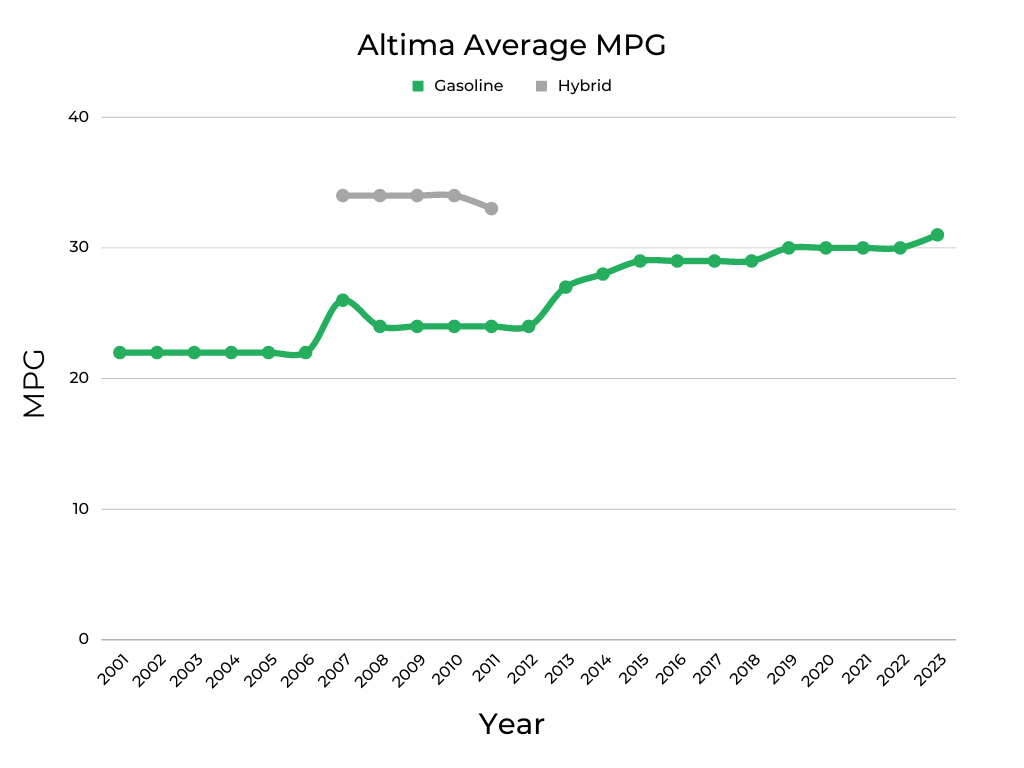
When shopping for a used family vehicle, fuel economy is an important factor to consider. The Nissan Altima could be more fuel-efficient, especially for older models, but it’s not too bad actually. While the Altima didn’t have a model averaging over 30 mpg until 2019 (except for its short-stinted hybrid), it is still comparable to the average miles per gallon of the Honda Accord.
Nissan released a hybrid Altima version in 2008 with an average fuel economy of 34 mpg but discontinued it after the 2011 model. You could consider the 2010 hybrid but, there were only 35,000 hybrids made over the 4 years of hybrid Altima production and it is likely that only 10,000 or less were made in 2010. It may be hard to find a 2010 Altima hybrid out there – on top of that (as we will cover later in this article) these hybrids had battery and electrical issues, so even if you find one, you probably don’t want to buy it.
Current Market Value of All Nissan Altima Years & Cost Per Year to Repair and Maintain Each
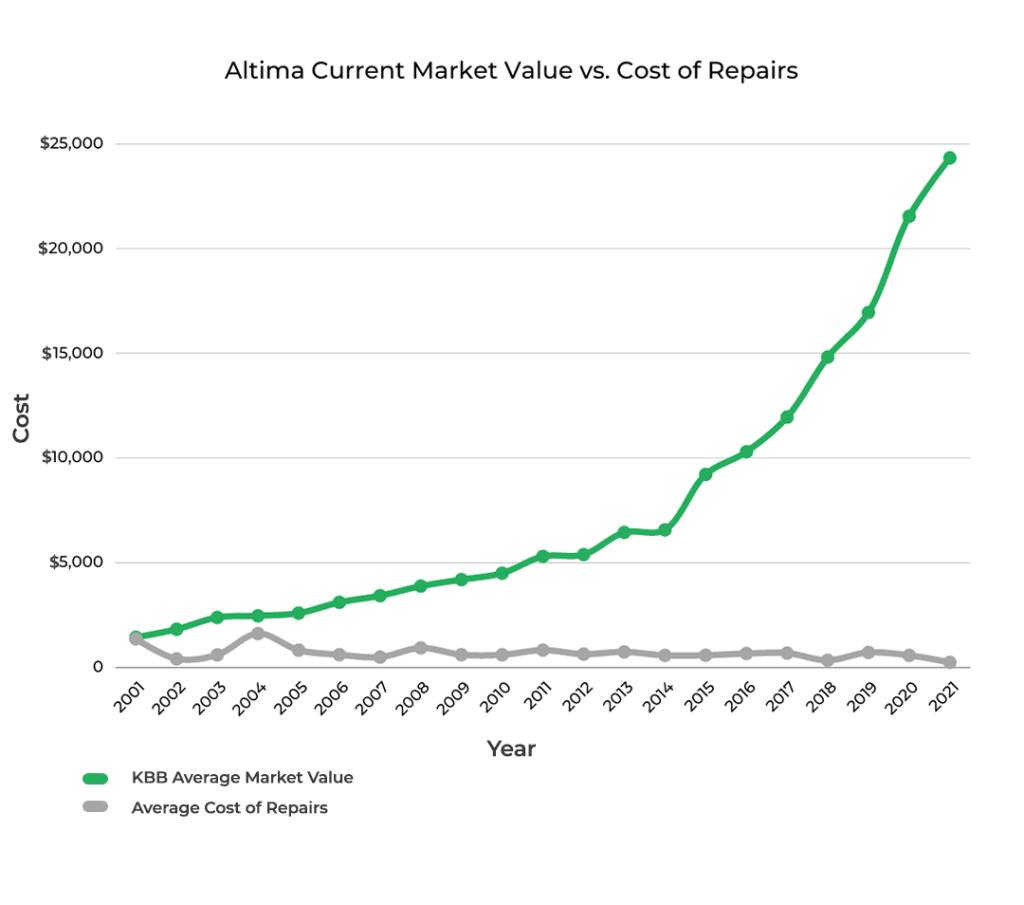
The market value of a Nissan Altima is another factor affected by engine reliability, cost of repairs, and average mileage of each year reported by owner surveys. The green line in this graph represents the KBB value, while the gray line shows the average cost per year to repair and maintain.
The repair costs of the Nissan Altima stay consistent, with a significant rise in the 2004 model. High costs make this year’s maintenance cost almost as much as the car’s overall value and are why 2004 is one of the worst years of the Nissan Altima.
The value of the 2014 Nissan Altima is slightly higher than that of 2013, as the repair costs decreased. While the 2014 model might be a good car to buy used, the lower KBB value is due to the big difference (in average miles reported on the odometer) between 2014(125,0000) and 2015 (99,138).
If you’d like to learn about this vehicle’s past depreciation rate & our projected depreciation rate based on that, check out: Nissan Altima | Depreciation Rate & Curve Graphed
When shopping for a used Nissan Altima, it’s important to keep in mind that not all vehicles are cared for equally. To protect yourself from lemons, take along a FIXD Sensor on your test drive. FIXD connects to a free app on your smartphone to tell you more about the vehicle you’re checking out, including check engine lights and other hidden issues that the owner or dealership may be attempting to hide. Click here to learn more and get FIXD for only $19.99 (regular price $59)!
Important Features Timeline
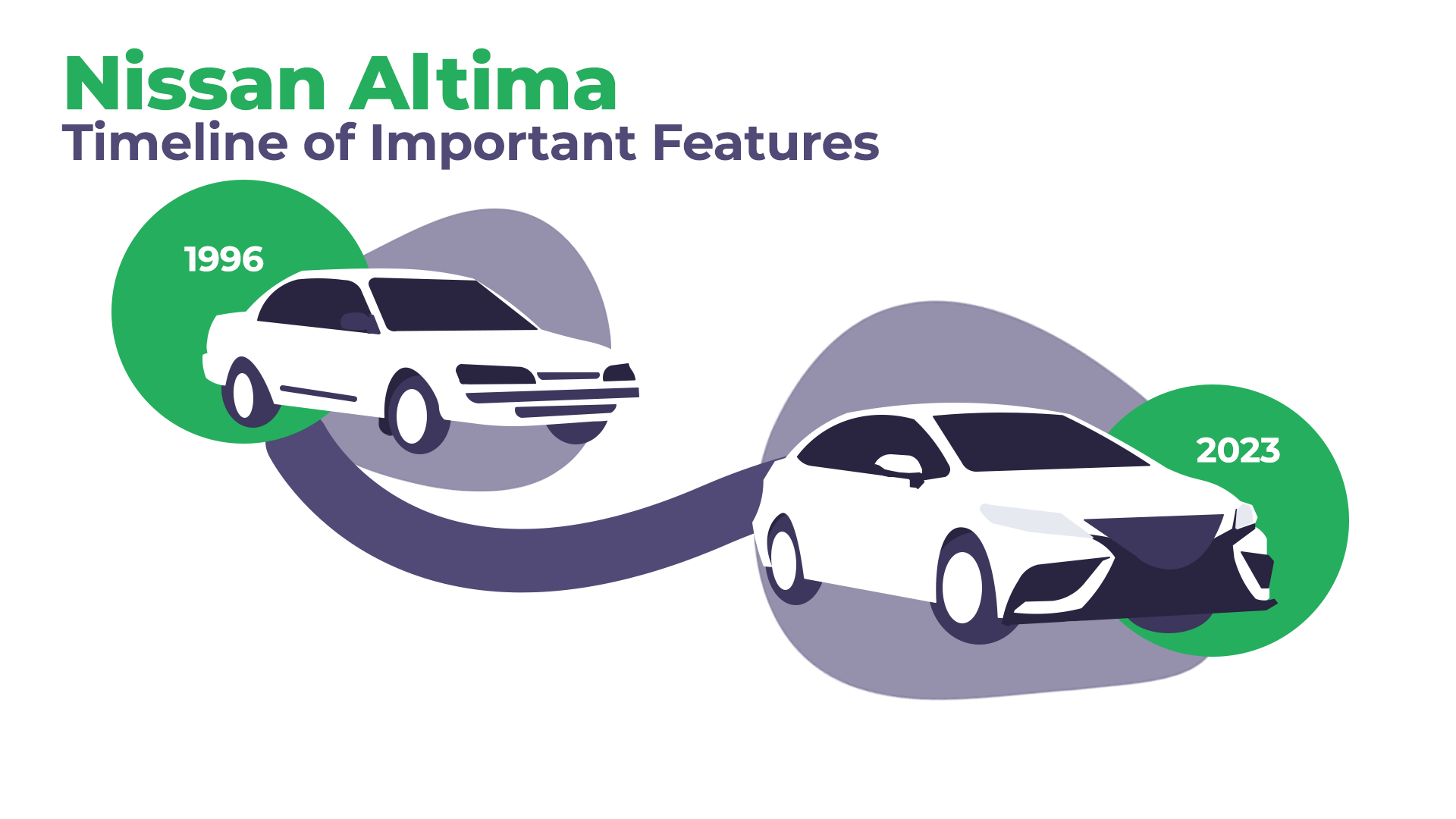
2001: New Limited Edition (LE) version of the GXE trim, in-dash 6-disc CD player
2002: First year of the 3rd generation, a complete redesign, optional traction control
2003: Small changes after last year’s redesign, two new exterior colors: Sonoma Sunset and Crystal Blue
2004: Standard tire pressure monitor system, 4-cylinder meets new emission standards, lowering horsepower from 175 to 170
2005: Exterior improvements, new headlamp design, DVD-based navigation system
2006: Four new package revisions, optional Bluetooth connectivity
2007: First-year model of the fourth generation, new continuously variable transmission, increased fuel economy
2008: Standard anti-lock brake system and electronic brakeforce distribution
2009: Power mirrors, a standard trip computer, three new exterior colors
2010: Revised front-end styling, available premium Bose audio system with nine speakers
2011: Relatively unchanged, three new exterior colors: Metallic Slate, Saharan Stone, and Brilliant Silver
2012: Discontinued the Nissan Altima Hybrid
2013: Revamped for the 5th generation, brand new design for both exterior and interior, standard rearview camera
2014: Sport Value package available for the 2.5 S trim, new NissanConnect app
2015: 3.5 SL trim comes with technology package and addition of exhaust variable camshaft timing, increasing fuel efficiency
2016: New Altima SR grade, first-time 18-inch wheels offered on 4-cylinder 2.5 liter Altima
2017: Unchanged from the previous year, the new SR midnight edition
2018: Base 2.5 and 3.5 SR no longer available, new 7-inch touchscreen display
2019: The redesigned beginning of 6th generation, all-wheel drive available for the first time
2020: Standard Nissan Safety Shield 360 suite of driver assistance features
2021: ProPilot assist offers advanced safety features such as forward collision warning and lane departure warning
2022: New Midnight edition package, primarily unchanged from the previous year
The Best Years of the Nissan Altima
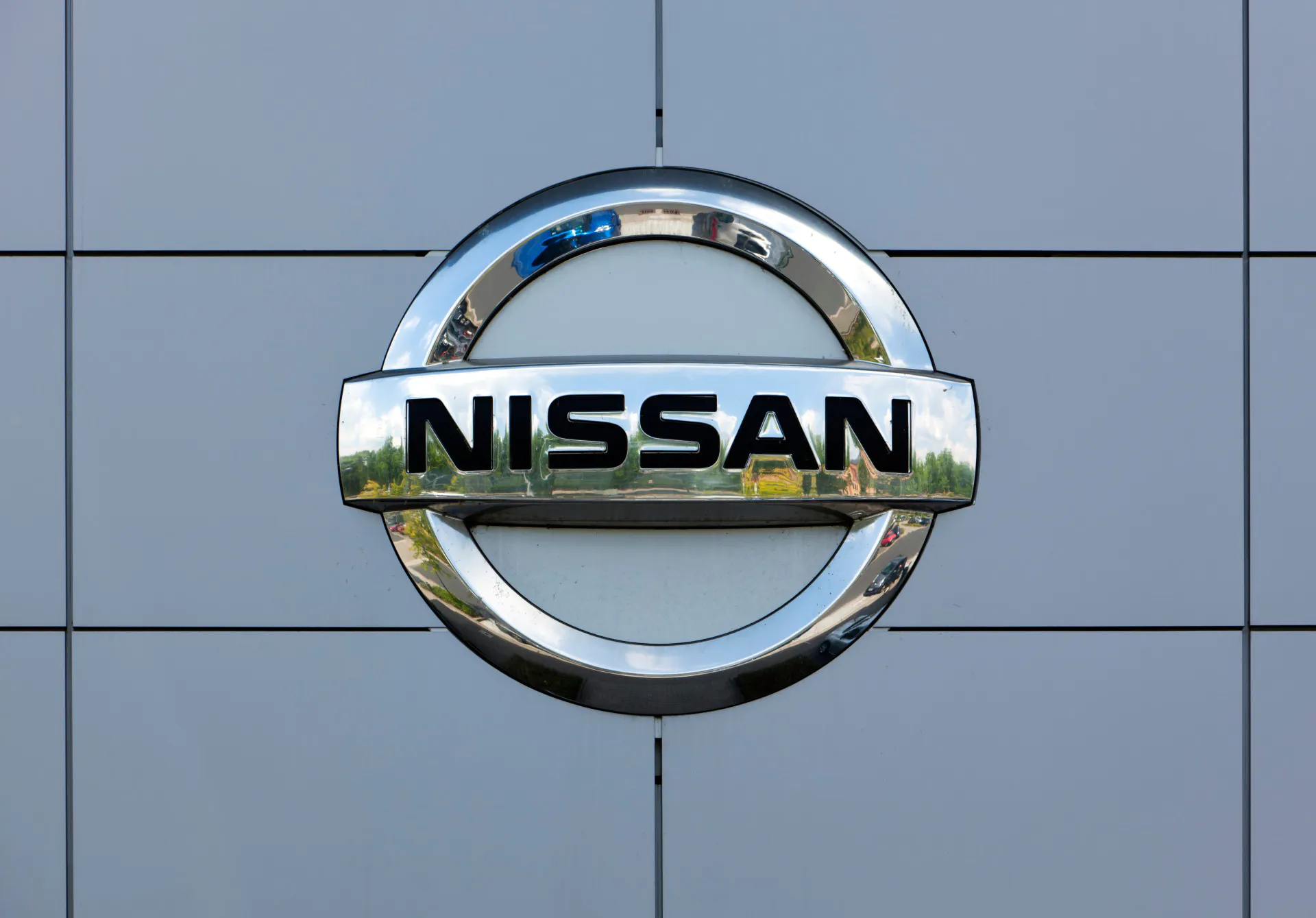
Following a comprehensive evaluation of the data, we have ranked the best years of the Nissan Altima, starting with the best of the best. The vehicles are mainly ranked based on their FIXD Reliability and Owner Reliability scores. We also examined NHTSA safety ratings, KBB value, maintenance and repair costs, and the average fuel economy of each Altima. Last, we listed some of the diagnostic trouble codes (DTC) that commonly plague each model year and some recalls that a potential buyer may want to ask the seller to get remedied at a Nissan dealership for free before they purchase the car.
2019-2021 Nissan Altima
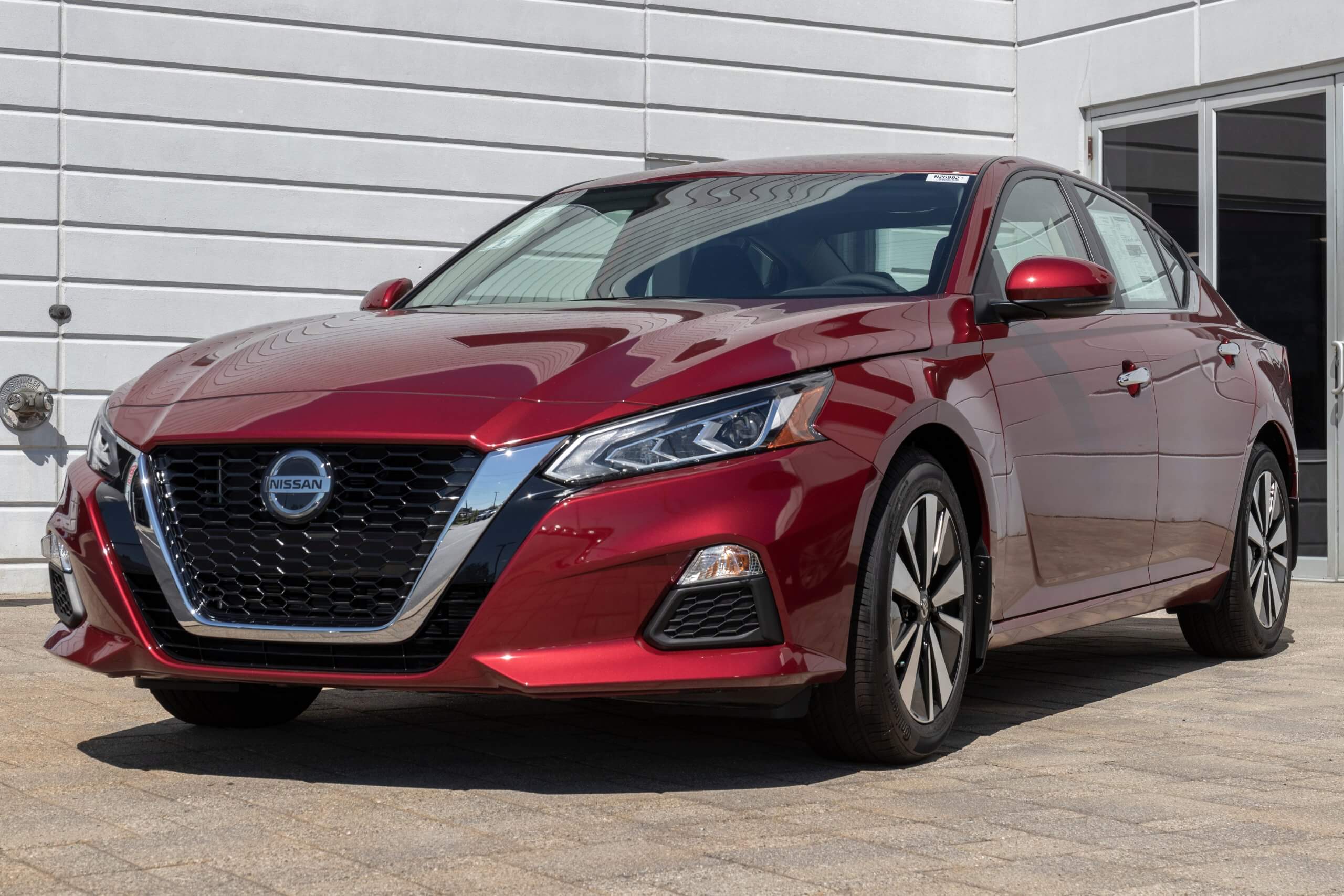
FIXD Reliability Score: 10/10
Owner Reliability Score: 7-10/10
KBB Value: $21,549-$24,332
Fuel Economy: 30 mpg
Annual Maintenance/Repair: $250-$722
Safety Rating: 4.6/5
2019-2021 is the best range of years for the Nissan Altima. 2019 is the first year of the 6th generation..
All three vehicles scored a perfect 10/10 on their FIXD Reliability Score, while only 2021 achieved a 10 on the Owner Reliability Score (2020 still scored 9/10). However, the 2019 Nissan Altima was significantly lower, at a 7 out of 10. Owner dissatisfaction may come from higher repair costs or more issued recalls.
The NHSTA safety rating of the 2019-2021 Nissan Altima is an impressive 4.6 out of 5. While this isn’t as high as the Toyota Camry in the same year (5/5), it is still a great score for a family car.
The average repair and maintenance costs for 2021 are low ($250), which you want for a newer vehicle. 2020 is over double that amount, though, sitting at $583. 2019 is also high for a car under five years old, costing owners $722.
89% of surveyed 2019 owners paid a repair bill of over $500 in the last year. The most likely $500+ repair is the brakes (12.5% of $500+ repairs).
High mileage is the likely reason for the 2019’s high repair costs and a high chance of a repair costing over $500. Owners who installed and used the FIXD app have reported an average of 70,000 miles driven on their 2019 Nissan Altima. This is a high number of miles driven for a car that is only four years old.
The number of check engine lights for 2019-2021 is low, resulting in the perfect 10/10 FIXD Reliability Score. However, our FIXD sensors reported some DTCs for each year. 2019’s most common were the mass airflow sensor, P0101, and an exhaust gas recirculation DTC, P0404
Common engine codes for the 2020 Nissan Altima include P0136, H02S2 Heater Control Circuit Low (Bank 2, Sensor 2), and the mass airflow sensor, P0101. DTC P0101 typically resulted in replacing the mass airflow sensor, which could cost between $172 and $309 for this car.
The 2021 Nissan Altima threw a CEL with the code P0171, Bank 1 System Too Lean. A vacuum leak, a dirty or faulty mass airflow sensor, or a clogged fuel filter could cause this DTC.
The first car of the 6th generation(2019) has the most recalls, with five. The 2020 Nissan Altima has four recalls, 63 complaints, and one investigation. The 2021 model is only plagued with one recall but has the same open investigation of Nissan Altimas rented to customers by rental companies with the open recalls.
2016-2018 Nissan Altima
FIXD Reliability Score: 6-8/10
Owner Reliability Score: 8/10
KBB Value: $10,302-$14,823
Fuel Economy: 29 mpg
Annual Maintenance/Repair: $350-$690
Safety Rating: 4-4.2/5
The 2016-2018 Nissan Altima is the end of the 5th generation. They have proven to be dependable vehicles for continuous driving.
The 2016-2018 Nissan Altima scored 8 out of 10 on the Owner Reliability Score.
The FIXD reliability score fluctuated a bit – both 2017 and 2018 scored 8/10, but 2016 got 6/10.
The safety rating for the 2016-2018 Altima is lower than other cars, such as the Toyota Camry (4.6 and 5) and Honda Accord (5/5). However, the Nissan scored a respectable 4 and 4.2 in their crash tests.
Repair and maintenance costs are above average for the 2016 Nissan Altima ($672). 2017 is higher at $690 and has a 93% chance of a repair costing over $500. The 2018 Nissan Altima has the second lowest repair and maintenance cost of all Altimas in our data, at $350.
The 2016 Nissan Altima reported a lower FIXD Reliability Score because of the higher number of CELs recorded. Its most common DTC was P0037 or H02S2 Heater Control Circuit Low. Another concerning code commonly reported for this year, P0420, may require a catalytic converter replacement ($1,538-$2,041) to repair.
A common engine code for the 2018 Nissan Altima is P0300, which could result in replacement ignition coils. Replacing ignition coils varies but averages between $51 and $173 in this Nissan Altima. The second most common code is P0101, Mass Airflow Sensor, and it could cost up to 309 dollars if it needs to be replaced.
Recalls for the 2016-2018 Altima are lower than many other years. There are four recalls and three investigations for the 2016 Altima.The 2017 Nissan Altima has three recalls, and the 2018 Nissan Altima only has two. Nissan performs recall repairs at no cost to the vehicle owner (Usually at a Nissan Dealership).
2013-2015 Nissan Altima
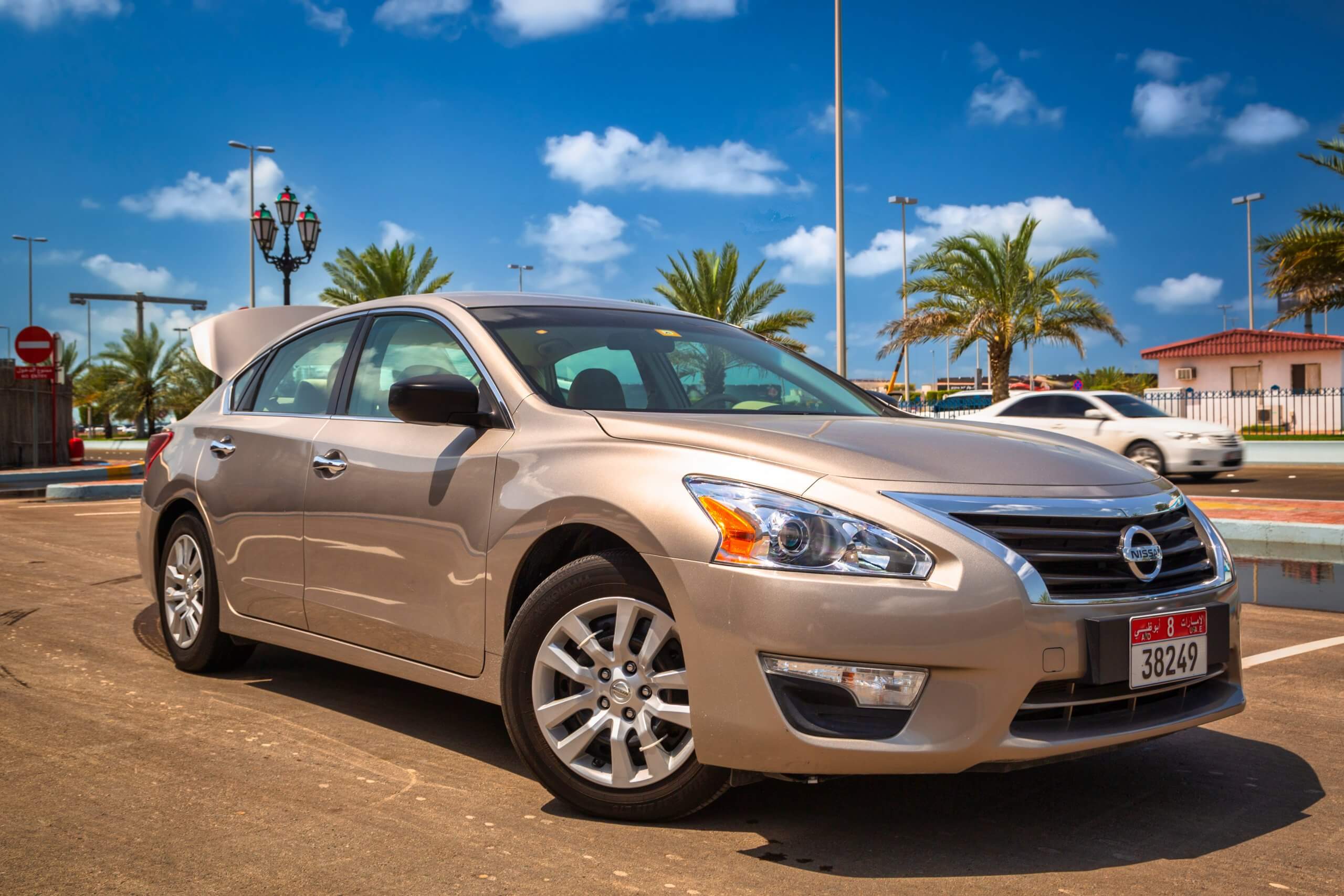
FIXD Reliability Score: 8/10
Owner Reliability Score: 8-9/10
KBB Value: $6,449-$9,221
Fuel Economy: 27-29 mpg
Annual Maintenance/Repair: $583-$750
Safety Rating: 4.2-5/5
The 2013-2015 Nissan Altimas were the first three years of the 5th generation. They were quickly popular due to their revamped, sportier look. While it had the usual first-year issues, these years are still good Altimas based on their FIXD and Owner Reliability Scores. They also have low annual maintenance costs and good safety ratings.
The 2013-2015 Nissan Altimas recorded a great FIXD Reliability Score of 8 out of 10. The Owner Reliability score fluctuated from 9/10 in 2013 to 8/10 in 2014 and 2015. Drivers like the great visibility and comfortable seating.
A major difference between these three years is the safety rating. Notably, the 2013 Nissan Altima doesn’t have data for the front and side safety but scored 5 out of 5 on the rollover rating. 2014’s rating is solid at 4.4, while 2015 drops slightly to 4.2.
Repair and maintenance costs are steady for the 2013-2015 Nissan Altima models, with a reported range of $583-$750. The chance of a $500 repair also remains steady – 2014 (92%), 2015 (92%), and 2016 (93%). Most expensive repairs are related to the brake system, which is common among any car that is close to 10 years old.
While it was more common in 2013 and 2014, all three-year models have a standard DTC code for the mass airflow sensor, P0101. As mentioned, the mass airflow sensor replacement can range from $172 to $309 for the Nissan Altima. The following most common DTC is P0420, catalyst system efficiency below threshold. If this results in replacing the catalytic converter, the costs can add up to $1,538-$2,041.
The 2013 and 2015 Nissan Altima had another common DTC, P0456. P0456 means an evaporative emissions control system leak, and something as simple as a loose gas cap could cause the light to trigger. The 2014 Nissan Altima reported a DTC P052B, Intake Camshaft Position (CMP) Actuator Solenoid. This DTC could cost $1,016-$1,531 to repair.
While the 2013-2015 Nissan Altima is one of the best Altimas, it does have its fair share of issues. One major drawback is a large number of recalls. The 2013 Nissan Altima has 12 recalls, 2014 has eight, and 2015 has ten. Even though manufacturers fix recalls without costing the owner a dime, it is essential to know them if you are in the market for one of these cars.
2012 Nissan Altima
FIXD Reliability Score: 7/10
Owner Reliability Score: 8/10
KBB Value: $5,393
Fuel Economy: 24
Annual Maintenance/Repair: $641
Safety Rating: 5/5
The last model year of the 4th generation, the 2012 Nissan Altima, rounds out the best Nissan Altimas to consider if you are shopping for a used car. Kelley Blue Book data shows that it has average annual repair costs and is affordable.
The FIXD Reliability Score for the 2012 Altima is at an above-average 7 out of 10. In addition, the Owner Reliability Score is one point higher at 8/10. These great scores contribute to this Altima being on our best list.
According to NHTSA, the 2012 Nissan Altima was not rated in front and side crash testing but scored a 5 out of 5 in the rollover testing.
Annual repair and maintenance bills for the 2012 Nissan Altima are lower than the average($669) at a reasonable $641. However, there is an 82% chance of a repair costing over $500.
Common DTCs in the 2012 Altima include P0101, which could require replacing the mass air flow sensor ($172-$309). The second most common engine code is P0420, a catalytic converter($1,538-$2,041). The third most common code is P0705. A range of different problems could cause DTC P0705.
NHTSA data reports that the 2012 Nissan Altima has only four recalls but has 406 complaints and one investigation. If you want to buy or sell this model, taking care of the recall repairs is important.
2010 Nissan Altima
FIXD Reliability Score: 7/10
Owner Reliability Score: 7/10
KBB Value: $4,504
Fuel Economy: 24 mpg
Annual Maintenance/Repair: $611
Safety Rating: 4.6/5
After the first three years of the 4th generation ended up on our worst list, Nissan finally had a winner with the 2010 Altima. With some revised styling and enhanced features, this car is popular because of its high safety rating and low annual repair costs.
The 2010 Nissan Altima scored 7 out of 10 on the FIXD and Owner Reliability Score. This is a great score, especially considering the average mileage for this year is 153,947.
If you’re shopping for a family vehicle, 2010 is an option. This Altima scored 4.6 out of 5 stars in its NHTSA safety rating.
Annual repair and maintenance costs are surprisingly low for a thirteen-year-old vehicle. The 2010 reports ownership costing $611, below average and better than multiple newer models (2011, 2016, 2017). However, there is a 90% chance of needing a $500 repair or greater.
DTCs for the 2010 Nissan Altima follow the trend of other years, with P0420 being one of the most common. It is followed by P0128, a coolant thermostat costing between $2,049 and $2,567.
Recalls issued by the NHTSA are low for this model year, with three, and the 2010 Altima only has 351 complaints. However, all three of these recalls are severe and should be taken care of before you consider buying a used 2010 Altima.
The Worst Years of the Nissan Altima
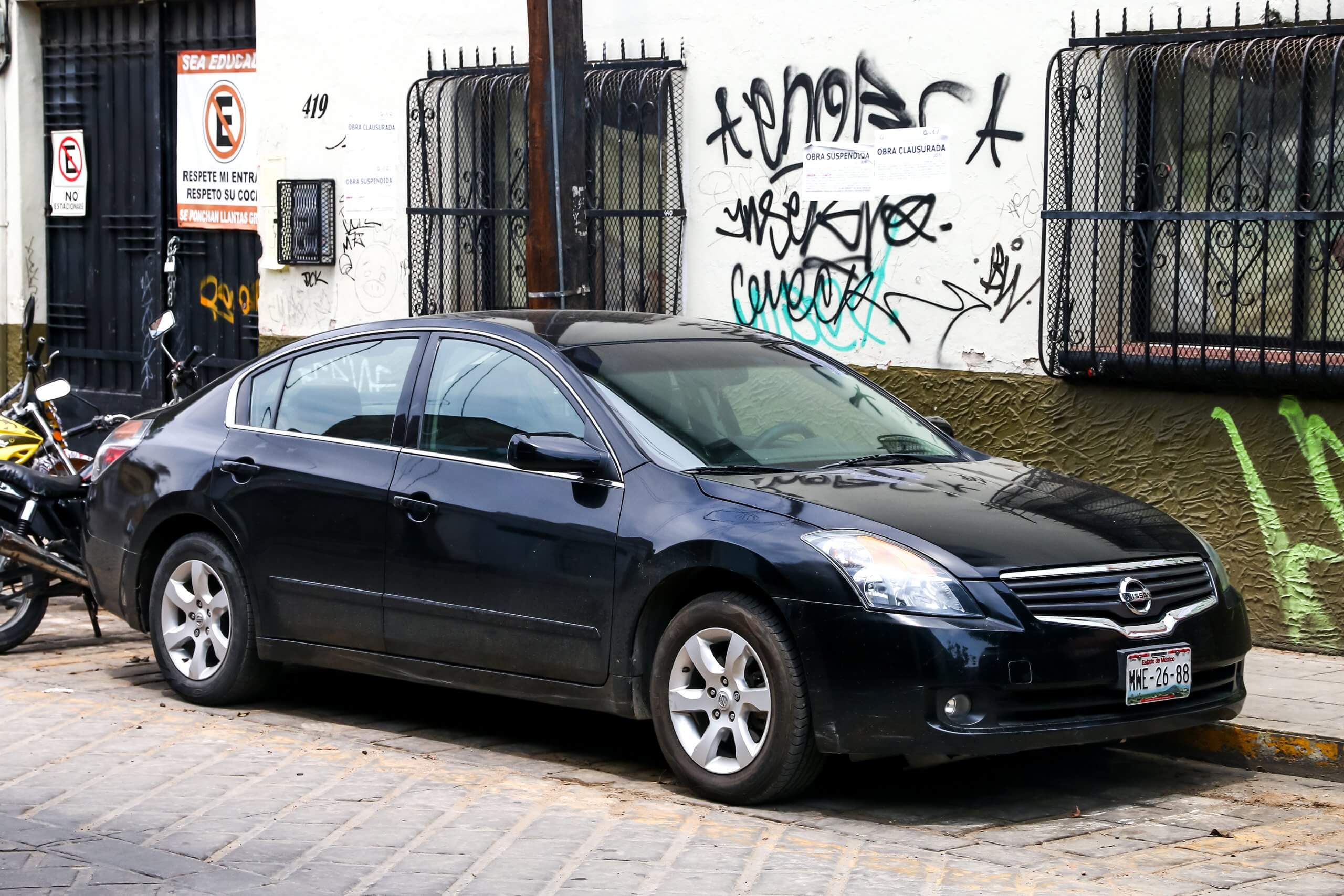
While most of the newer models are a good choice of the Nissan Altima, there are some years to avoid if you’re shopping used. We ranked the worst years of the Nissan Altima using FIXD Reliability Scores, Owner Reliability Scores, KBB value data, safety ratings, and fuel economy. We also listed the most common codes causing check engine lights in these years.
2002-2004 Nissan Altima
FIXD Reliability Score: 1-2/10
Owner Reliability Score: 4-9/10
KBB Value: $1,829-$2,470
Fuel Economy: 22 mpg
Annual Maintenance/Repair: $417-$1,625
Safety Rating: 3.8/5
The 2002-2004 Nissan Altima is problematic for several reasons. They are the third generation’s freshman, sophomore, and junior years. They were initially well received, but many recalls, and low safety scores landed them on our list of worst Altimas.
The 2002 and 2003 Altima had the lowest FIXD Reliability Score on our chart, with 1 out of 10. 2004 only improved by one point, 2/10. The Owner Reliability Scores do the opposite dance, with 2002 starting at an average of 9/10, dropping to 5/10 for 2003, and dropping again to 4/10 for the 2004 Altima.
The 2002 Altima has the biggest difference in Owner and FIXD Reliability scores and is a big enough difference to be highly noticeable on our graph. The high owner score could be because people think the car is more reliable than it is or that we have less data on older years like this.
While the 2002 may not be reliable now, it was probably very reliable in its prime, the 2002 Nissan Altima won “North America Car of the Year” award actually. The average reported mileage for the 2002 is 191,667 miles, which is on the high end for a car of that time. For an owner of a car with that many miles (especially if they owned it since it was new) this is perceivably a really reliable car, it just isn’t that reliable when compared to today’s cars with newer designs and less worn out parts.
The average safety scores for the 2002-2004 Altimas were 3.8 out of 5. It dropped below four because the driver-side crash test only scored 3 out of 5 stars. This safety rating is far below the 2003-2004 Honda Accord, which scored 4.8 out of 5.
Owner maintenance cost for the 2002 Nissan Altima is surprisingly low, at $417. The repair bills for 2003 and 2004 are both high but vary greatly. 2003 Nissan Altima costs an average of $603 a year to maintain, which is below average and reasonable for a twenty-year-old car. However, the 2004 Altima has a whopping $1,625 annual repair cost. Our data shows a 100% chance of an engine repair costing over $500. Couple this with the low KBB value, and it is best to avoid these models altogether.
The most common diagnostic engine code for 2002-2004 is the P0420, which may require an expensive catalytic converter replacement( $1,538-$2,041). P0128, engine coolant thermostat, and P0011, intake camshaft timing caused the next most common CELs for 2003. These DTCs are serious and should be repaired as soon as possible. P0128 usually requires a thermostat replacement, while P0011 needs a new timing chain ($1,046-$1,615).
The 2004 Nissan Altima reports a high number of P0300, leading to a replacement cylinder head gasket, costing somewhere between $2,226 and $3,770. It also threw the code P0301, which might need ignition coils. Ignition coils are a less expensive fix at $51-$173.
The 2003-2004 Nissan Altima has plenty of problems that should sway you from considering these particular years. Another wary point is the high number of recalls. 2002 has the most recalls with twelve. It also reports one investigation and 1,060 complaints. 2003 Nissan Altima has ten recalls, while the 2004 Altima has issued five.
2001 Nissan Altima
FIXD Reliability Score: 3/10
Owner Reliability Score: 3/10
KBB Value: $1,444
Fuel Economy: 22 mpg
Annual Maintenance/Repair: $1,375
Safety Rating: 3.75/5
The 2001 Nissan Altima is the last year of the 2nd generation, and you should avoid it if you are considering purchasing a used Altima. While it was popular in 2001, it doesn’t have high reliability scores and has maintenance costs almost as high as its overall value.
On both the FIXD Reliability Score and the Owner’s Reliability Score, the 2001 Nissan Altima scored 3/10. This score is well below average and is a primary reason we recommend staying away from this year of Altima if you find one for sale.
The safety rating for the Altima is only 3.75 out of 5. This rating is lower than its main competitors – the 2001 Accord scored 4.8, and the 2001 Camry scored 4 out of 5. These ratings are essential since most Nissan Altimas are used for large amounts of driving and/or as a family vehicle.
Repair bills are extremely high for the 2001 Nissan Altima. Annual maintenance and repairs average around $1,444, more than double the average across all Nissan Altimas for which we have collected data.
There are plenty of diagnostic trouble codes to round out the last model of the 3rd generation. The most common code that the 2001 Nissan Altima throws is the P1126 engine coolant thermostat. Repairing the thermostat might cost $2,049 to $2,567, far more than the car is worth. The following code thrown at an alarming rate was P0420. As previously indicated, P0420 may require a catalytic converter and cost up to $2,041.
The National Highway Transportation Safety Administration reports that only two recalls are issued for the 2001 Nissan Altima.
2005-2006 Nissan Altima
FIXD Reliability Score: 2-4/10
Owner Reliability Score: 6/10
KBB Value: $2,598-$3,113
Fuel Economy: 22 mpg
Annual Maintenance/Repair: $614-$833
Safety Rating: 4/5
The 2005-2006 Nissan Altimas have low reliability scores and fuel economy compared to its competitors.
While 2005 scored a below-average 4 out of 5 for its FIXD Reliability Score, it dropped to an abysmal 2/10 for 2006. The Owner Reliability Score stays at 6/10 for both years.
The NHTSA safety rating is a reasonable 4 out of 5 stars but still falls in the shadow of the industry-leading Honda and Toyota safety scores.
The yearly cost of ownership for the 2006 Altima is $614, a little less than average, but 2005 has a much higher $833 annual repair cost.
The chance of a $500 repair is 92% for the 2006 and 75% for the 2005 (there is a 25% chance of that 2005 repair being related to the engine.)
The most common repair code for 2005 and 2006 is Catalyst System Efficiency Below Threshold (P0420). Again, this is an expensive repair if you must replace the catalytic converter (up to $2,041). The next most popular DTCs for 2005 are Random Multiple Misfire (P0300) and Downstream Oxygen Sensor (P1273). The repairs for these issues can cost $51-$173 and $153-$306, respectively.
These model years have minimal recalls. For example, the 2005 Nissan Altima only has two, while the 2006 has four recalls and 814 complaints.
2007-2009 Nissan Altima
FIXD Reliability Score: 5-6/10
Owner Reliability Score: 6-7/10
KBB Value: $3,429-$4,197
Fuel Economy: 24-26 mpg
Annual Maintenance/Repair: $500-$938
Safety Rating: 4.6-4.8/5
2007-2009 is another range of the Nissan Altima to avoid. 2007 was the first model of the 4th generation and brought new problems with the new era. While their reliability stays around average, they have high repair costs.
The 2007-2009 FIXD Reliability Scores went from 5 to 6 out of 10. Owner Reliability Score ranges from 6-7/10.
The 2007-2009 Altimas have excellent safety ratings compared to older models, scoring 4.6 and 4.8 out of 5 stars. These ratings are comparable to its competitors in this category.
Repair bills for the 2007 Altima are only $500, but 2008 is almost double at $938. 2009 reports a below average annual maintenance cost of $614. There is an 88% (2007), 92% (2008), and 75% (2009) chance you’ll need a repair that costs over $500.
The most common DTC is the Catalyst System Below Efficiency (P0420), causing concern that the catalytic converter must be replaced ($1,538-$2,041). The next most common code is P0128, the engine coolant thermostat that could cost between $2,049 and $2,567. It also had high reports of Multiple Misfires Detected (P0300), which replaced ignition coils ($51-$173).
The 2007 and 2008 Nissan Altima have Body Control Module recalls. The NHTSA issued three recalls for 2007, and the 2008 model has four. The 2009 Altima has only four recalls but reports 1,526 complaints by owners.
2011 Nissan Altima
FIXD Reliability Score: 6/10
Owner Reliability Score: 7/10
KBB Value: $5,304
Fuel Economy: 24 mpg
Annual Maintenance/Repair: $833
Safety Rating: 4.2/5
While the 2011 Nissan Altima isn’t the worst on the list, it is not among the best years due to high repair costs and lower safety ratings.
The FIXD Reliability Score for 2011 is 6/10 and is lower than the previous year due to a higher diagnostic trouble codes. However, the Owner Reliability Score is a respectable 7/10.
While the safety rating for the 2011 Nissan Altima is not terrible at 4.2, it could be better than the years surrounding it (2010 had 4.6 while 2012 scored 5/5). This year also has a rare victory over the Toyota Camry, with its 2011 model scoring 3.4 out of 5.
Owning a 2011 Altima will cost you $833 yearly, almost $200 more than the average of all Nissan Altimas. You are also 77% likely to have a hefty $500 repair.
DTCs are the main factor contributing to the FIXD Reliability Score. The most common check engine light for the 2011 Altima was caused by the mass airflow sensor (P0101), which costs $172-$309. The next DTC is the typical villain, P0420, usually resulting in a pricey ($1,538-$2,041) catalytic converter replacement. The following engine code on the list for 2011 is P0031, HO2S Heater Control Circuit Low (Bank 1, Sensor 1).
While there is only one recall for the 2011 Altima, it is related to transverse link bolts and could cause a crash if not fixed. All recalls are fixed at no cost to the vehicle owner and should be taken to a licensed dealer for repair.
FAQs
What years of the Nissan Altima have engine and/or transmission problems?
One model year of the Nissan Altima with multiple complaints about the transmission is 2013. Hundreds of reported complaints about shifting, hesitation, and even complete transmission failure exist. In addition, some owners have reported problems with the continuously variable transmission, resulting in decreased performance.
The 2002 Nissan Altima has complaints about the engine and even issued a few recalls regarding the crankshaft position sensor and an engine stall.
What is considered high mileage for a Nissan Altima?
The Nissan Altima data from FIXD sensors and owner surveys suggests that the highest average mileage is 200,000 in the 2001 model year. However, the average of all the years is only 124,549 miles.
The data would suggest anything over 150,000 might be considered high mileage for a Nissan Altima. We recommend an individual inspection to determine the high mileage for a particular Altima. Each car owner drives in different ways under different conditions. In addition, some vehicle owners must catch up on their maintenance, affecting the car’s longevity.
Do any hybrid years have problems?
The Nissan Altima only had a hybrid version from 2007 to 2011. It discontinued the hybrid after it struggled to take off (low sales numbers).
The hybrid version of the Nissan Altima has had thousands of complaints across its short life. The majority of those complaints were about the electrical system. A common issue amongst hybrid vehicles is that the battery system drains if the car sits dormant for too long.
Besides the complaints, the Nissan Altima Hybrid had several recalls, including one from 2008-2010 that caused an overheating battery to melt the navigation system or cause a fire.
What other vehicles should I consider?
While it is a good choice for many people, Nissan Altima shoppers have alternatives to consider regarding used vehicles. Other mid-size sedans have comparable or better reliability scores, safety ratings, and fuel economy.
One vehicle a possible Nissan Altima owner could consider is the Toyota Camry. It has an excellent reputation for dependability and high resale value. In addition, it has excellent safety ratings and would be great for taking the family on long road trips. The Camry also has a hybrid version that could save you some money at the pumps.
Another car worth looking at is the Honda Accord. It is known for reliability, safety features, and performance. In addition, the Honda Accord is a great family vehicle with a comfortable and spacious interior: a hybrid option and many different engine options.
Mazda has a comparable midsize car, the Mazda 6. This car is known for its sporty look and has a turbocharged option. It also has a slew of safety features and an easy-to-use entertainment center.
If you’re looking to increase space and step into the world of small SUVs, the Toyota RAV4 and Honda CR-V are great vehicles. They both provide more interior room for a comfortable ride when you’re commuting or driving with the family. They are also highly safe and reliable vehicles.
What owners of the Nissan Altima like to use their car for:
Most Nissan Altima owners use their cars to travel or for long commutes. According to our owner surveys, 42% of Nissan Altima drivers use it for extended driving, while 41% bought the car as a family vehicle. Another 7% use it for luxurious driving, 5% for fast driving, and 3% for an office on wheels. Less than 2% of people use the car for off-roading and towing.
| Frequent Use Categories: | How Useful? (Out of 5 Stars) |
| Family Vehicle | ***** |
| Lots of Driving (travel/long commute) | ***** |
| Hauling/Towing | * |
| Office on Wheels | * |
| Sport/Fast Driving | * |
| Luxurious Driving | * |
| Outdoor/Off-Road | * |
A Note About Data and Information Sources
This article has many details about Nissan Altima’s reliability; here’s what we used for our assumptions and recommendations.
- FIXD Reliability Score & Data: Engine reliability information is captured via the FIXD App.
The FIXD Reliability Score is calculated using the number of DTCs per year, weighted by mileage. This is then turned into a scale of 1-10 for easy graphing.
This is an objective score.
- Owner Reliability Score & Data: This data is the result of surveying Nissan Altima owners who use FIXD.
The Owner Reliability Score comes straight from owners of the Nissan Altima.
This is a subjective score.
To determine the Owner Reliability Score we ask each car owner:
How reliable would you say your Nissan Altima is?
a. Just point A to point B driving
b. A Daily Commuter
c. Good for a 100-mile road trip
d. Good for a 500-mile road trip
e. I could take a cross-country road trip, no problem
From here we translate their answers into the Owner Reliability Score:
a. = 2
b. = 4
c. = 6
d. = 8
e. = 10
Keep in mind, owners may think their car is more or less reliable than it actually is.
One potential problem is that people often buy the same make or model they are used to when they go car shopping, just a newer year.
Ford, for instance, has a number of consumer loyalty awards for the Ford F-Series, Ford Mustang, and Ford Expedition.
Car owners may be so loyal to the make or model they currently own that they would have trouble accurately comparing their cars’ reliability to others.
It’s for this reason that the Owner Reliability Score. We intentionally ask car owners a question that is relative to mileage rather than relative to other cars.
Still, be mindful of the accuracy of these Owner Reliability Scores, people’s perceptions and unconscious blindspots can skew data.
We suggest looking at both the FIXD Reliability Score and the Owner Reliability Score for this reason.
- KBB Value: Average private-seller valuations as supplied by Kelley Blue Book (KBB), based on a Nissan Altima with typical mileage for that respective model year.
- Fuel Economy: Mileage-per-gallon estimates according to the EPA MPG on Fueleconomy.gov
- Annual Maintenance/Repair: Upkeep expenses as reported by surveyed Nissan Altima owners
- Safety Rating: Crash test data collected and reported by NHTSA. We average all ratings for each year to come up with a simplified, average safety score. This makes it easier to look at on a graph.
References
- Nissan Altima model-specific information, edmunds.com (various dates). Retrieved April 17, 2023, from https://www.edmunds.com/
- Model-specific recall information as per the National Highway Transportation Safety Administration. Retrieved April 17, 2023, from https://www.nhtsa.gov/recalls
- Model-specific information nissannews.com (various dates) Retrieved April 17, 2023, from https://usa.nissannews.com/en-US
- Nissan Altima Generations, by Autolist Editorial, autolist.com (September 8, 2020) Retrieved April 17, 2023, from https://www.autolist.com/nissan-altima/nissan-altima-generations
- Nissan Altima Receives 2002 “North American Car of the Year Award”, Nissan Motor Corporation (January 7, 2002) Retrieved April `9, 2023 from https://global.nissannews.com/en/releases/release-bf090b679338e231c9f9f84f1deda485-020107-01#:~:text=Detroit%20(January%206%2C%202002), International%20Auto%20Show%20in%20Detroit

Keith Rollins is a copywriter and author that has been involved in the automotive industry for over 12 years. He has written for hotcars.com and is featured on Copywriting.org. When he’s not writing he’s spending time with his three kids, hiking, working on cars, or running. You can see his work at keithrrollins.com.

